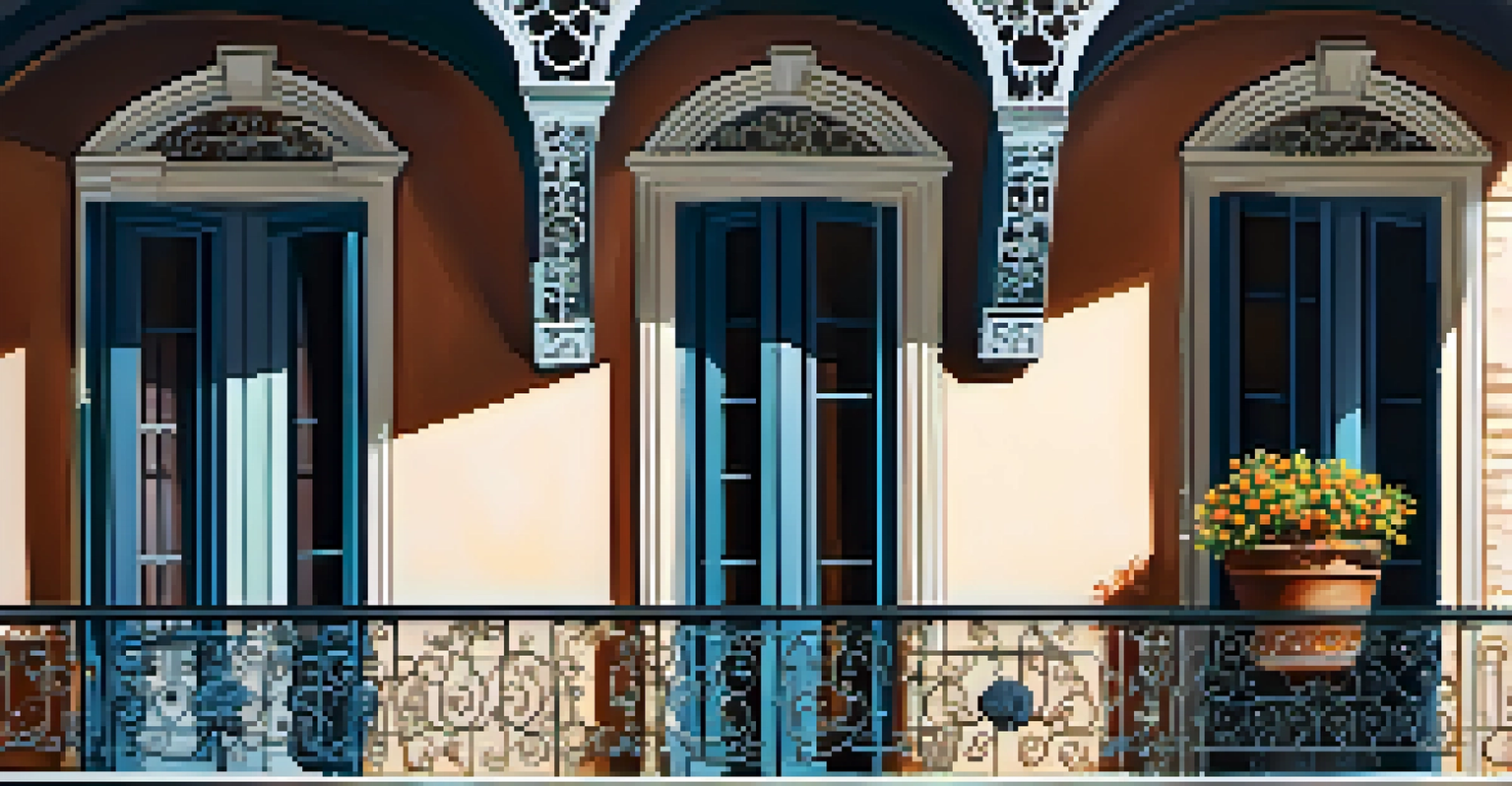Preserving New Orleans Architecture: Challenges and Efforts

The Unique Charm of New Orleans Architecture
New Orleans architecture reflects a rich tapestry of cultures, histories, and influences, from French and Spanish to African and Creole. The iconic shotgun houses, grand mansions, and ornate courtyards tell stories of the city's past. Each structure adds to the vibrant character of neighborhoods, making the city a living museum of architectural styles.
Preservation is a form of empowerment, allowing communities to reclaim their identity and tell their stories through the architecture that surrounds them.
This unique charm is not just aesthetic; it plays a significant role in the city's identity. Visitors and locals alike are drawn to the historic buildings that evoke a sense of nostalgia and connection. However, preserving this architectural heritage is crucial, as it embodies the culture and history that define New Orleans.
As climate change and urban development continue to pose threats, protecting these architectural gems has become increasingly vital. The challenge lies in balancing modernization with preservation, ensuring that the spirit of New Orleans remains intact for future generations.
The Impact of Climate Change on Preservation Efforts
Climate change is one of the most pressing challenges facing New Orleans architecture, with rising sea levels and extreme weather events threatening the city's foundations. Historic buildings are often more vulnerable due to their age and construction methods. This reality forces preservationists to confront the question: how do we safeguard these structures without compromising their integrity?

Many organizations are working diligently to protect these buildings. For example, they are implementing flood-resistant techniques and advocating for sustainable construction practices. These efforts not only aim to preserve the physical structures but also ensure that the communities surrounding them remain resilient.
Preserving New Orleans' Unique Heritage
The architectural styles of New Orleans reflect its diverse cultural history, making preservation vital for maintaining the city's identity.
However, the ongoing battle against climate change requires continuous adaptation and innovation. As the city navigates these challenges, it must also foster a culture of awareness and responsibility among residents, encouraging them to value and protect their architectural heritage.
Legal Framework for Historic Preservation
The legal framework surrounding historic preservation in New Orleans is essential for protecting its unique architecture. Various laws and regulations, such as the National Historic Preservation Act, provide guidelines for maintaining and restoring historic sites. These legal protections help ensure that any renovations or developments respect the historical significance of the buildings.
The buildings we inhabit are a reflection of our history, culture, and values. They tell us who we are and where we come from.
Local organizations, like the Vieux Carré Commission, play a critical role in enforcing these regulations. They review proposed changes to historic properties and provide recommendations that align with preservation goals. This collaborative effort between government and community stakeholders is vital for maintaining the city's architectural integrity.
However, navigating these legal waters can sometimes be complicated. Property owners may struggle to balance personal interests with the requirements of preservation, leading to conflicts that require careful mediation and education.
Community Involvement in Preservation Initiatives
Community involvement is a cornerstone of successful preservation efforts in New Orleans. Local residents often have a deep emotional connection to their neighborhoods and the historic buildings within them. Engaging the community fosters a sense of ownership, empowering individuals to advocate for the preservation of their architectural heritage.
Various grassroots organizations and neighborhood associations work tirelessly to raise awareness about the importance of preserving local architecture. They host events, workshops, and discussions that educate residents on the value of their historical surroundings. This grassroots activism plays a vital role in driving preservation efforts forward.
Community Drives Preservation Efforts
Local residents' emotional connections to their neighborhoods empower them to advocate for the preservation of historic buildings.
Moreover, volunteer opportunities, like clean-up days and restoration projects, allow community members to actively participate in preserving their environment. These initiatives not only beautify neighborhoods but also strengthen community bonds and instill pride in local heritage.
The Role of Technology in Preservation
Technology has emerged as a powerful ally in the fight for architectural preservation in New Orleans. Advanced tools like 3D scanning and digital modeling allow preservationists to create accurate representations of historic structures. This technology enables more effective planning for restoration projects, ensuring that the original character of buildings is maintained.
Additionally, social media and online platforms have become vital for raising awareness about preservation efforts. Organizations can share success stories and engage a wider audience, mobilizing support for their initiatives. This digital outreach helps to cultivate a community of advocates who are passionate about preserving the city's architectural legacy.
Yet, while technology enhances preservation efforts, it also poses challenges. The rapid pace of digital development raises questions about how to integrate modern innovations into historic contexts without detracting from their authenticity.
Funding Challenges for Preservation Projects
Funding is often a significant hurdle in preservation efforts, as many projects require substantial financial resources. Securing grants and donations can be competitive, with numerous organizations vying for limited funding. This challenge makes it essential for preservationists to articulate the importance of their projects clearly and compellingly.
Local, state, and federal funding opportunities exist, but they often come with stringent requirements and lengthy application processes. Navigating this landscape can be daunting for grassroots organizations and individual property owners looking to restore their historic homes. Collaboration between various stakeholders can sometimes help pool resources and share costs.
Technology Aids Preservation Initiatives
Advanced tools and digital platforms enhance the effectiveness of preservation efforts while raising awareness about the importance of protecting architectural heritage.
Creative fundraising strategies, such as community events and crowdfunding campaigns, have emerged as effective means to garner support. By fostering a sense of community around preservation, these initiatives not only raise funds but also increase awareness and appreciation for New Orleans' architectural heritage.
Success Stories in Architectural Preservation
Despite the challenges, there are numerous success stories in New Orleans' preservation efforts that inspire hope and determination. Restoration of historic landmarks, such as the St. Louis Cathedral and the Cabildo, showcases how dedication and collaboration can revive architectural treasures. These projects not only restore physical structures but also breathe new life into the surrounding communities.
Community-led initiatives have also successfully transformed neglected neighborhoods into vibrant, culturally rich areas. For instance, the revitalization of the Tremé neighborhood has resulted in the preservation of its historic homes and a renewed sense of pride among residents. These achievements highlight the power of collective action in preserving architectural heritage.

These success stories serve as reminders that preservation is not just about buildings; it's about people and their stories. By celebrating these victories, New Orleans can continue to inspire future generations to appreciate and protect its unique architectural landscape.